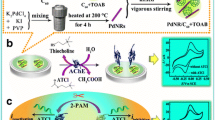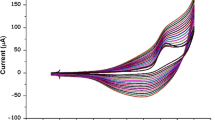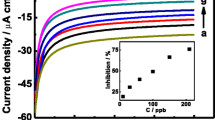Abstract
The authors describe an amperometric biosensor for the determination As(III) and Cd(II) based on the inhibition of the enzyme acetylcholineesterase (AChE). A platinum electrode was modified with ruthenium(II)-tris(bipyridyl), graphene oxide and AChE and then showed redox peaks at 0.06 and 0.2 V vs Ag/AgCl in the presence of acetylthiocholine chloride (ATChCl). Amperometry unveiled a steady-state turnover rate with the release of thiocholine. In the presence of arsenic(III) and cadmium(II), AChE showed an inhibitive response at 0.214 and 0.233 V vs Ag/AgCl, respectively. The electrode exhibits a detection limit and linear range of 0.03 μM and 0.05–0.8 μM for As(III) and 0.07 μM and 0.02–0.7 μM for Cd(II), respectively. Type of inhibition and inhibition constants induced by As(III) and Cd(II) on the catalytic sites of AChE were determined from Dixon and Lineweaver-Burk plots. The modified electrode was applied to the determination of As3+ and Cd2+ in river, tap and waste water, and the results proved that the method is sensitive and can be an alternative to chromatographic and spectroscopic techniques.

Schematic presentation of Pt/Ru(II)-tris(bipy)-GO/AChE electrode in absence and presence of metal ions (As3+/Cd2+).


Similar content being viewed by others
References
Huang M-R, Ding Y-B, Li X-G (2013) Lead-ion potentiometric sensor based on electrically conducting microparticles of sulfonic phenylenediamine copolymer. Analyst 138:3820–3829. https://doi.org/10.1039/c3an00346a
Ghica ME, Carvalho RC, Amine A, Brett CMA (2013) Glucose oxidase enzyme inhibition sensors for heavy metals at carbon film electrodes modified with cobalt or copper hexacyanoferrate. Sensors Actuators B Chem 178:270–278. https://doi.org/10.1016/j.snb.2012.12.113
Zhang H, Ding J, Du D (2015) Electrochemical evaluation of the mechanism of acetylcholinesterase inhibition based on an electrodeposited thin film. Int J Electrochem Sci 10:1632–1645
Stoytcheva M, Sharkova V, Panayotova M (1998) Electrochemical approach in studying the inhibition of acetylcholinesterase by arsenate(III): analytical characterisation and application for arsenic determination. Anal Chim Acta 364:195–201. https://doi.org/10.1016/S0003-2670(98)00134-2
Sanllorente-Méndez S, Domínguez-Renedo O, Julia Arcos-Martínez M (2010) Immobilization of acetylcholinesterase on screen-printed electrodes. Application to the determination of arsenic(III). Sensors 10:2119–2128. https://doi.org/10.3390/s100302119
Deshpande K, Mishra RK, Bhand S (2010) A high sensitivity micro format chemiluminescence enzyme inhibition assay for determination of hg(II). Sensors 10:6377–6394. https://doi.org/10.3390/s100706377
Kumar DN, Roy J, Alex SA et al (2016) Spectrofluorimetric determination of hg 2+ and Pb 2+ using acetylcholinesterase (AChE)-based formation of silver nanoparticles. RSC Adv 6:21261–21270. https://doi.org/10.1039/C6RA00193A
Florescu M, Badea M, Coman G, Mitrica M (2009) Screen printed electrodes used for detection of ionic heavy metals. Bull Transilv Univ Brasov 2:49–54
Amine A, Arduini F, Moscone D, Palleschi G (2016) Recent advances in biosensors based on enzyme inhibition. Biosens Bioelectron 76:180–194. https://doi.org/10.1016/j.bios.2015.07.010
Qian S, Lin H (2015) Colorimetric sensor array for detection and identification of organophosphorus and carbamate pesticides. Anal Chem 87:5395–5400. https://doi.org/10.1021/acs.analchem.5b00738
Chauhan N, Narang J, Jain U (2015) Highly sensitive and rapid detection of acetylcholine using an ITO plate modified with platinum-graphene nanoparticles. Analyst 140:1988–1994. https://doi.org/10.1039/c4an01873g
Xia N, Wang Q, Liu L (2015) Nanomaterials-based optical techniques for the detection of acetylcholinesterase and pesticides. Sensors (Basel) 15:499–514. https://doi.org/10.3390/s150100499
Gumpu MB, Murugan V, Krishnan UM, Rayappan JBB (2017) Simultaneous electrochemical detection of cd(II), Pb(II), as(III) and hg(II) ions using ruthenium(II)-textured graphene oxide nanocompoiste. Talanta 162:574–582
Dai H, Wang N, Wang D, Ma H, Lin M (2016) An electrochemical sensor based on phytic acid functionalized polypyrrole/graphene oxide nanocomposites for simultaneous determination of cd(II) and Pb(II). Chem Eng J 299:150–155. https://doi.org/10.1016/j.cej.2016.04.083
Murugan V, Hunter R, Neethirajan S (2015) Lipoxygenase-modified Ru-bpy / graphene oxide : electrochemical biosensor for on-farm monitoring of non-esterified fatty acid. Biosens Bioelectron 78:253–258. https://doi.org/10.1016/j.bios.2015.11.058
Zhao G, Li J, Ren X et al (2011) Few-layered graphene oxide nanosheets for heavy metal ion pollution management. Environ Sci Technol 45:10454–10462. https://doi.org/10.1021/ses203439v
Veerapandian M, Hunter R, Neethirajan S (2016) Ruthenium dye sensitized graphene oxide electrode for on-farm rapid detection of beta-hydroxybutyrate. Sensors Actuators B Chem 228:180–184. https://doi.org/10.1016/j.snb.2016.01.028
Veerapandian M, Lee M-H, Krishnamoorthy K, Yun K (2012) Synthesis, characterization and electrochemical properties of functionalized graphene oxide. Carbon N Y 50:4228–4238. https://doi.org/10.1016/j.carbon.2012.05.004
Ovalle M, Stoytcheva M, Zlatev R et al (2008) Electrochemical study on the type of immobilized acetylcholinesterase inhibition by sodium fluoride. Electrochim Acta 53:6344–6350. https://doi.org/10.1016/j.electacta.2008.04.062
Arduini F, Guidone S, Amine A et al (2013) Acetylcholinesterase biosensor based on self-assembled monolayer-modified gold-screen printed electrodes for organophosphorus insecticide detection. Sensors Actuators B Chem 179:201–208. https://doi.org/10.1016/j.snb.2012.10.016
Stoytcheva M, Zlatev R, Velkova Z et al (2009) Analytical characteristics of electrochemical biosensors. Port Electrochim Acta 27:353–362. https://doi.org/10.4152/pea.200903353
Du D, Chen S, Song D et al (2008) Development of acetylcholinesterase biosensor based on CdTe quantum dots/gold nanoparticles modified chitosan microspheres interface. Biosens Bioelectron 24:475–479. https://doi.org/10.1016/j.bios.2008.05.005
Migliorini FL, Sanfelice RC, Pavinatto A et al (2017) Voltammetric cadmium(II) sensor based on a fluorine doped tin oxide electrode modified with polyamide 6/chitosan electrospun nanofibers and gold nanoparticles. Microchim Acta 184:1077–1084. https://doi.org/10.1007/s00604-017-2082-x
Fuku X, Iftikar F, Hess E et al (2012) Cytochrome c biosensor for determination of trace levels of cyanide and arsenic compounds. Anal Chim Acta 730:49–59. https://doi.org/10.1016/j.aca.2012.02.025
Male KB, Hrapovic S, Santini JM, Luong JHT (2007) Biosensor for arsenite using arsenite oxidase and multiwalled carbon nanotube modified electrodes. Anal Chem 79:7831–7837. https://doi.org/10.1021/ac070766i
Wang T, Milton RD, Abdellaoui S et al (2016) Laccase inhibition by Arsenite/arsenate: determination of inhibition mechanism and preliminary application to a self-powered biosensor. Anal Chem 88:3243–3248. https://doi.org/10.1021/acs.analchem.5b04651
Guascito MR, Malitesta C, Mazzotta E, Turco A (2008) Inhibitive determination of metal ions by an amperometric glucose oxidase biosensor. Sensors Actuators B Chem 131:394–402. https://doi.org/10.1016/j.snb.2007.11.049
Ghica ME, Brett CMA (2008) Glucose oxidase inhibition in poly(neutral red) mediated enzyme biosensors for heavy metal determination. Microchim Acta 163:185–193. https://doi.org/10.1007/s00604-008-0018-1
Tekaya N, Saiapina O, Ben Ouada H et al (2013) Ultra-sensitive conductometric detection of heavy metals based on inhibition of alkaline phosphatase activity from Arthrospira platensis. Bioelectrochemistry 90:24–29. https://doi.org/10.1016/j.bioelechem.2012.10.001
Bagal-Kestwal D, Karve MS, Kakade B, Pillai VK (2008) Invertase inhibition based electrochemical sensor for the detection of heavy metal ions in aqueous system: application of ultra-microelectrode to enhance sucrose biosensor’s sensitivity. Biosens Bioelectron 24:657–664. https://doi.org/10.1016/j.bios.2008.06.027
Silwana B, Van Der Horst C, Iwuoha E, Somerset V (2014) Amperometric determination of cadmium, lead, and mercury metal ions using a novel polymer immobilised horseradish peroxidase biosensor system. J Environ Sci Health A Tox Hazard Subst Environ Eng 49:1501–1511. https://doi.org/10.1080/10934529.2014.937169
Acknowledgements
This work is supported by Department of Science & Technology, New Delhi (DST/TM/WTI/2 K14/197(a)(G)), (SR/FST/ETI-284/2011 (C)), SASTRA (Deemed to be University), Thanjavur. Dr. Manju Bhargavi Gumpu expresses sincere thanks to Science and Engineering Research Board, Department of Science and Technology for Post-Doctoral Fellowship (PDF/2017/001206).
Author information
Authors and Affiliations
Corresponding author
Ethics declarations
The author(s) declare that they have no competing interests.
Electronic supplementary material
ESM 1
(DOCX 1978 kb)
Rights and permissions
About this article
Cite this article
Gumpu, M.B., Veerapandian, M., Krishnan, U.M. et al. Amperometric determination of As(III) and Cd(II) using a platinum electrode modified with acetylcholinesterase, ruthenium(II)-tris(bipyridine) and graphene oxide. Microchim Acta 185, 297 (2018). https://doi.org/10.1007/s00604-018-2822-6
Received:
Accepted:
Published:
DOI: https://doi.org/10.1007/s00604-018-2822-6




